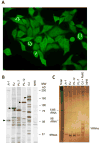Idiopathic inflammatory myopathies and the anti-synthetase syndrome: a comprehensive review
- PMID: 24424190
- PMCID: PMC3970575
- DOI: 10.1016/j.autrev.2014.01.022
Idiopathic inflammatory myopathies and the anti-synthetase syndrome: a comprehensive review
Abstract
Autoantibodies are a hallmark in the diagnosis of many systemic autoimmune rheumatic diseases (SARD) including idiopathic inflammatory myopathies (IIM). Based on their specificity, autoantibodies in IIM are grouped into myositis specific (MSA) and myositis associated autoantibodies (MAA). Among the MSA, autoantibodies against aminoacyl-tRNA synthetases (ARS) represent the most common antibodies and can be detected in 25-35% of patients. The presence of ARS and other autoantibodies has become a key feature for classification and diagnosis of IIM and is increasingly used to define clinically distinguishable IIM subsets. For example, anti-ARS autoantibodies are the key features of what has become known as anti-synthetase syndrome (aSS), characterized by multiple organ involvement, primarily interstitial lung disease, often accompanied by myositis, non-erosive arthritis, Raynaud's phenomenon, fever, and "mechanic's hands". Autoantibodies directed to eight different ARS have been described: Jo-1 (histidyl), PL-7 (threonyl), PL-12 (alanyl), OJ (isoleucyl), EJ (glycyl), KS (asparaginyl), Zo (phenylalanyl) and Ha (tyrosyl). Each anti-ARS antibody seems to define a distinctive clinical phenotype. Although several research methods and commercial tests are available, routine testing for anti-ARS autoantibodies (other than anti-Jo-1/histidyl-tRNA synthetase) is not widely available, sometimes leading to delays in diagnosis and poor disease outcomes.
Keywords: Autoantibodies; Immunoassay; Jo-1; Myositis; Synthetase.
Copyright © 2014 Elsevier B.V. All rights reserved.
Conflict of interest statement
M. Mahler, is employed at INOVA Diagnostics a manufacturer of autoantibody kits and assays. M.J. Fritzler is a paid consultant of ImmunoConcepts Inc. and INOVA Diagnostics and has received diagnostics gifts in kind from Euroimmun.
Figures

References
Publication types
MeSH terms
Substances
Supplementary concepts
Grants and funding
LinkOut - more resources
Full Text Sources
Other Literature Sources
Medical
Miscellaneous

